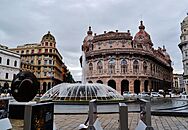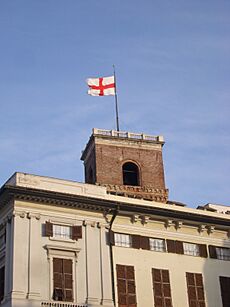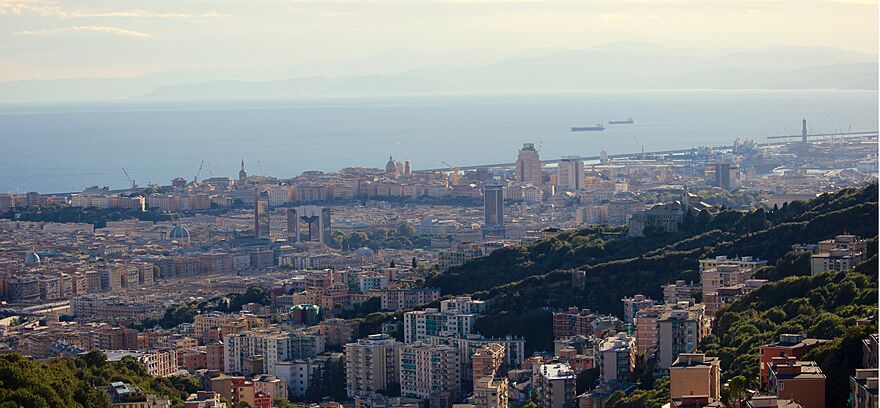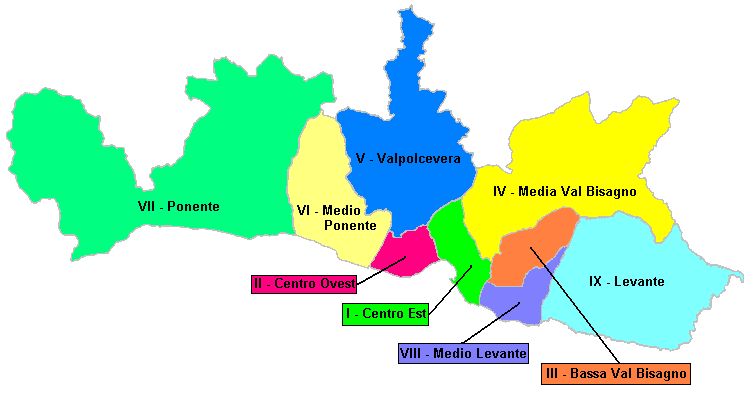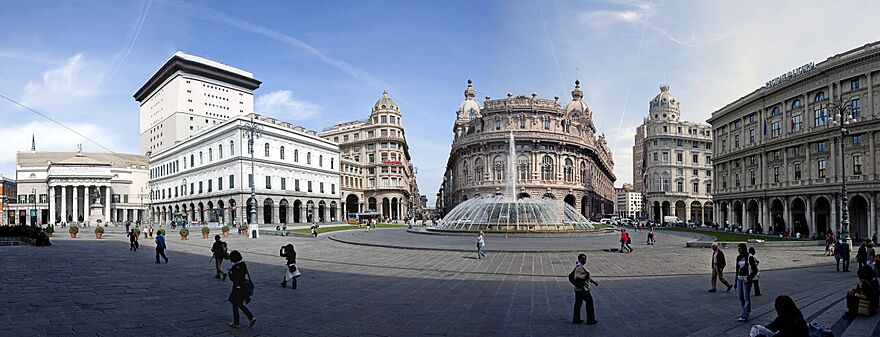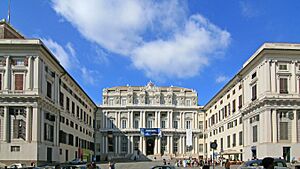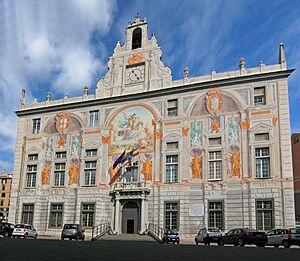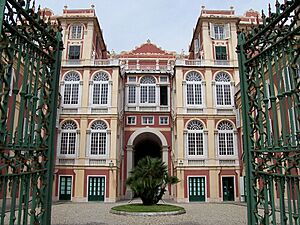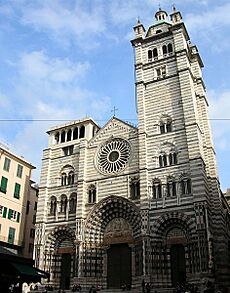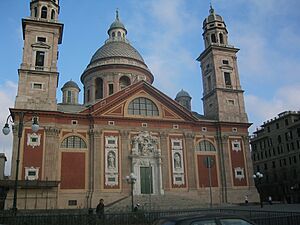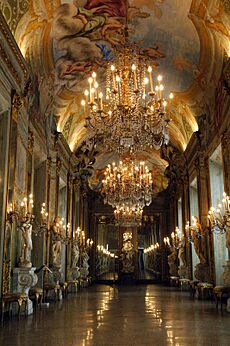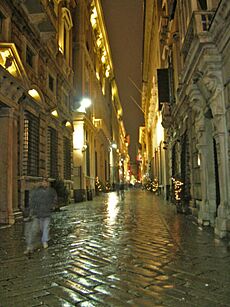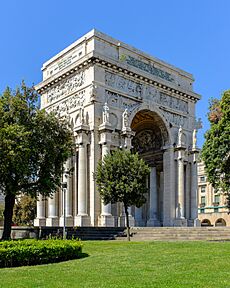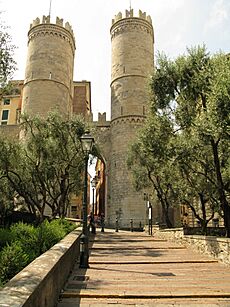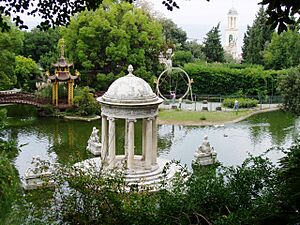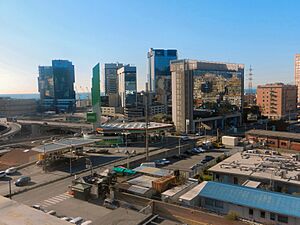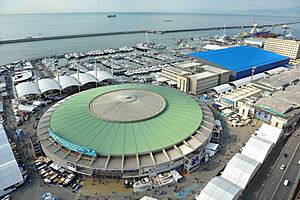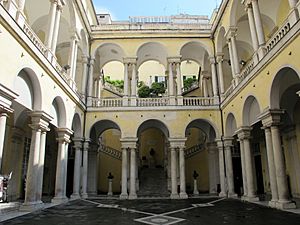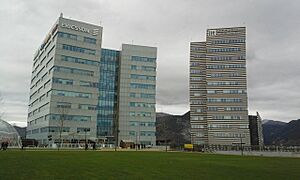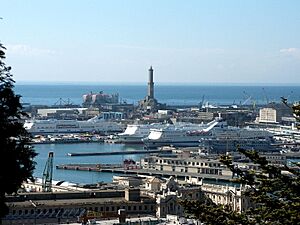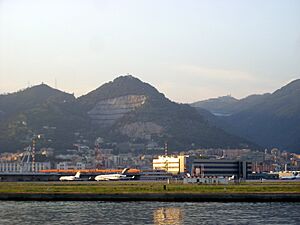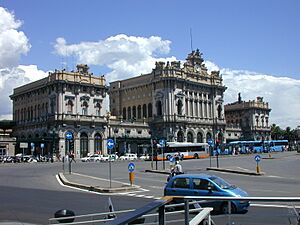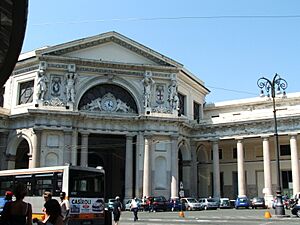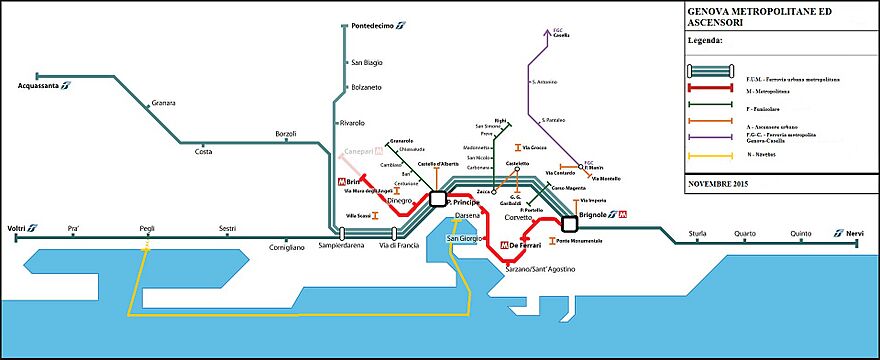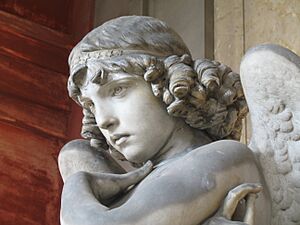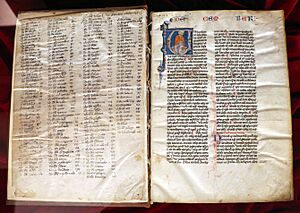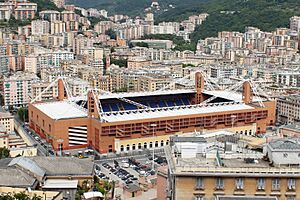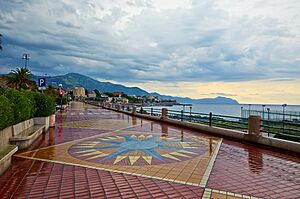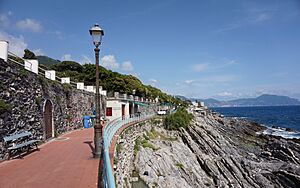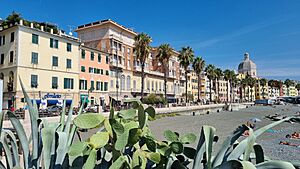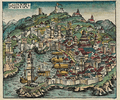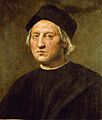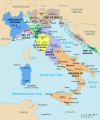Genoa facts for kids
Quick facts for kids
Genoa
|
|||
|---|---|---|---|
| Comune di Genova | |||
|
Skyline of Genoa
DeFerrari Square
Genoa Cathedral
Saint George Palace
Garibaldi Street
Boccadasse
Doge's Palace
20th September Street
Pegli Lungomare
Nervi's small dock
|
|||
|
|||
| Country | Italy | ||
| Region | Liguria | ||
| Area | |||
| • Total | 240.29 km2 (92.78 sq mi) | ||
| Elevation | 20 m (70 ft) | ||
| Population
(2025)
|
|||
| • Total | 563,947 | ||
| • Density | 2,346.94/km2 (6,078.56/sq mi) | ||
| Demonym(s) | Genoese, Genovese | ||
| Time zone | UTC+1 (CET) | ||
| • Summer (DST) | UTC+2 (CEST) | ||
| Postal code |
16121-16167
|
||
| Dialing code | 010 | ||
| Patron saint | John the Baptist | ||
| Saint day | 24 June | ||
Genoa (pronounced JEN-oh-uh) is a big city in Italy. It's the capital of the Liguria region and the sixth-largest city in the country. As of 2025, over 560,000 people live here. If you include the wider area, more than 1.5 million people call Genoa home.
Located on the Gulf of Genoa in the Ligurian Sea, Genoa has always been a super important port on the Mediterranean Sea. It's the busiest port in Italy and one of the busiest in Europe!
For over 700 years, from the 11th century to 1797, Genoa was the capital of a powerful maritime republic. This means it was like its own country, ruled by its navy and merchants. From the 12th to the 15th century, Genoa was a leader in trade across Europe. It became one of the strongest naval powers and one of the richest cities in the world. The famous poet Petrarch even called it la Superba ("the proud one") because of its amazing achievements at sea and its beautiful buildings.
Genoa has been home to large shipyards and steel factories since the 1800s. Its strong financial history goes way back to the Middle Ages. The Bank of Saint George, started in 1407, was the oldest known state bank in the world. It played a huge part in the city's success.
The old part of Genoa, called the historical center, is one of the largest and most crowded in Europe. Part of it, known as Le Strade Nuove and the Palazzi dei Rolli, became a UNESCO World Heritage Site in 2006. This old town is famous for its narrow streets, which locals call "caruggi." Genoa is also home to the University of Genoa, which started way back in the 1400s. Because of its rich history in art, music, and food, Genoa was chosen as the European Capital of Culture in 2004. Many famous people were born here, including Christopher Columbus and Niccolò Paganini.
Genoa is a major economic hub in Italy, forming the southern part of the Milan-Turin-Genoa industrial area. Many important Italian companies, like Fincantieri (shipbuilding) and Costa Cruises (cruise lines), are based in the city.
Contents
What's in a Name?
The name "Genoa" might come from the Latin word genu, meaning "knee." This could refer to the city's shape or location. Some people think it comes from the Roman god Janus, who had two faces, just like Genoa looks out to both the sea and the mountains. Another idea is that it comes from the Latin word ianua, meaning "door" or "passage," because Genoa was a gateway to the sea. The city's old Latin name, oppidum Genua, was recorded by the Roman writer Pliny the Elder.
It's also possible the name has an Etruscan origin, from the word Kainua, meaning "New City."
Genoa's Story Through Time
Early Days and Roman Rule
People have lived in the Genoa area since about 5,000 to 4,000 BC. This makes it one of the oldest cities in the world where people have continuously lived! Around 500 BC, the first town was built by the ancient Ligures people on a hill called Castello. This town was known as "the market of the Ligurians" because it was a busy trading spot.
During the Second Punic War, Genoa was allied with Rome. Because of this, the Carthaginians destroyed the town in 209 BC. But Genoa was rebuilt and, after the wars ended in 146 BC, it became a Roman town. It grew from the Castello hill towards the areas of Santa Maria di Castello and San Lorenzo. People traded things like animal skins, wood, and honey. Goods were moved between Genoa and other big cities like Tortona and Piacenza.
From the Middle Ages to Modern Times
A Powerful Republic Rises
After the Western Roman Empire fell, Genoa was taken over by different groups, including the Ostrogoths and Byzantines. In 934-935, a fleet from North Africa attacked and burned the town. But Genoa slowly rebuilt its merchant fleet, which became the best in the Western Mediterranean.
Genoa really started to grow during the First Crusade (around 1097). About 10,000 people lived in the city then. Genoese ships and soldiers helped the crusaders, especially during the siege of Antioch and the Siege of Jerusalem (1099).
Being a strong sea power helped Genoa get many good trade deals. Genoese merchants controlled a lot of trade in the Byzantine Empire and other places. Even though Genoa lost some land after Saladin's campaigns in the late 1100s, it kept its free trading rights in Egypt and Syria.
Rivalries and New Inventions
In the 1200s, Genoa and Venice were big rivals in trade and culture. Venice had gained a lot of control over trade in the eastern Mediterranean. To get back its share, Genoa teamed up with the Byzantine emperor Michael VIII Palaiologos. This alliance helped Genoa get free trade rights in the Byzantine Empire, and islands like Chios and Lesbos became important trading posts for Genoa. Genoa also took over many settlements in Crimea, like the colony of Caffa. This made Genoa even richer and more powerful, while reducing trade for Venice and Pisa.
Around the 1300s, Genoa is also credited with inventing blue jeans! The fabric was a strong, affordable cloth, similar to cotton corduroy. The Genoese navy used jeans for their sailors because the fabric could be worn wet or dry.
Banking and Exploration
In the 1400s, two of the world's first banks were founded in Genoa: the Bank of Saint George (1407) and the Monte di Pietà (1483). Christopher Columbus was born in Genoa around 1451. He even gave some of his earnings from his voyages to the Bank of Saint George to help with food taxes. Rich Genoese families, like the Doria and Grimaldi, became incredibly wealthy.
Genoa then became a close partner of the Spanish Empire. Genoese bankers helped fund many of Spain's adventures abroad. From 1557 to 1627, some historians call it the "age of the Genoese" because their influence was so strong, yet quiet. Genoese bankers provided money to the Spanish rulers, and in return, silver from the Americas was quickly sent to Genoa to fund more projects. However, Genoa's trade depended on controlling the Mediterranean Sea. Losing Chios to the Ottoman Empire in 1566 was a big blow.
A Slow Decline
From the 1600s, the Genoese Republic slowly started to decline. In 1625, a French-Savoian army briefly attacked Genoa. Even though Spain helped lift the siege, the French later attacked the city again in 1684 for supporting Spain. A terrible plague also killed about half of Genoa's people in 1656–1657.
In 1729, Genoa faced a revolution in Corsica as people fought for independence. This long and costly conflict led to Corsica declaring itself a republic in 1755. Genoa, being weak, had to give Corsica to France in 1768. Just a year later, Napoleon Bonaparte was born in Corsica.
The Republic of Genoa finally fell in June 1797 when Napoleon's forces invaded. They created a new state called the Ligurian Republic, which was under French control.
The 1800s: Joining Italy
After Napoleon's power ended, Genoa briefly became independent again for less than a year. But then, the Congress of Vienna decided that Genoa and its lands would become part of the Kingdom of Sardinia.
In the 1800s, Genoa became a major seaport and an important center for steel and shipbuilding. Many important companies were founded here, like Gio. Ansaldo & C. (shipbuilding) in 1853 and Costa Crociere (ferry company) in 1854. By 1874, Genoa was fully connected by railway lines to France and the rest of Italy.
The 1900s and Today
In the 1900s, Genoa continued to grow. The Torre Piacentini, one of Europe's first skyscrapers, was built here in the 1930s. Genoa also started hosting big events like the Genoa International Boat Show (1962) and Euroflora (1966), a flower exhibition.
In 1992, Genoa celebrated the 500th anniversary of Christopher Columbus's voyage to the Americas with the Genoa Expo '92. The old port area was completely rebuilt and expanded, with famous architect Renzo Piano leading some of the work.
In July 2001, Genoa hosted the 27th G8 summit, a meeting of world leaders. In 2004, the European Union named Genoa a European Capital of Culture.
Sadly, on August 14, 2018, the Ponte Morandi bridge collapsed, causing 43 deaths. The remains of the bridge were taken down in 2019. A new bridge, the Genoa-Saint George Bridge, designed by Renzo Piano, was opened in August 2020. This quick rebuilding project, known as the "Genoa model," has helped push forward other important city projects, like the Levante Waterfront.
Since 2021, the Mayor Marco Bucci and the President of Liguria Giovanni Toti have been working on a new plan to modernize Genoa. In 2023, Genoa was the finish line for The Ocean Race, a famous sailing competition. In 2024, Genoa was named the European Capital of Sport. The city is looking forward to its "Genoa 2030" plan for development and renewal.
Genoa's Flag
The flag of Genoa is a St. George's Cross: a red cross on a white background.
Genoa's patron saint used to be Saint Lawrence. But sometime in the 1000s or 1100s, probably during the Crusades, the Genoese started honoring Saint George (and Saint John the Baptist) more. Genoa had a cross banner since at least 1218. This cross flag became the main flag of Genoa in the 1300s.
Some stories say that the flag of England came from the Genoese flag during the Third Crusade in 1190, but this isn't proven by history.
Where is Genoa?
The city of Genoa covers about 243 square kilometers between the Ligurian Sea and the Apennine Mountains. It stretches along the coast for about 30 kilometers and goes inland for about 10 kilometers along the Polcevera and Bisagno valleys. Genoa is divided into five main areas: the center, west, east, Polcevera, and Bisagno Valley. While much of the city center is low, the areas around it are mountainous and steep.
Genoa is close to two popular vacation spots in Liguria: Camogli and Portofino. The Aveto Natural Regional Park is also in the Genoa area.
Genoa's Weather
Genoa has a hot-summer Mediterranean climate. This means it has hot, dry summers and mild, wet winters. Because it's located between the sea and mountains, different parts of Genoa have slightly different weather.
The average yearly temperature is around 20°C during the day and 14°C at night. In the coldest months (January-February), it's about 12°C during the day and 6°C at night. In the warmest months (July-August), it's around 28°C during the day and 22°C at night. The sea helps keep temperatures mild, unlike areas behind the mountains where summers are hotter and winters are colder.
It rarely snows a lot in the city center, but it does happen almost every year. Genoa often gets heavy rain in the autumn. It's also a windy city, especially in winter when cool northern winds blow from the Po Valley.
| Climate data for Genoa (1991–2020 normals), 2 m asl, sunshine 1971–2000, extremes since 1955 | |||||||||||||
|---|---|---|---|---|---|---|---|---|---|---|---|---|---|
| Month | Jan | Feb | Mar | Apr | May | Jun | Jul | Aug | Sep | Oct | Nov | Dec | Year |
| Record high °C (°F) | 20.3 (68.5) |
22.5 (72.5) |
25.0 (77.0) |
29.4 (84.9) |
32.8 (91.0) |
35.6 (96.1) |
35.4 (95.7) |
38.3 (100.9) |
34.2 (93.6) |
28.9 (84.0) |
22.9 (73.2) |
20.8 (69.4) |
38.3 (100.9) |
| Mean daily maximum °C (°F) | 12.1 (53.8) |
12.7 (54.9) |
15.2 (59.4) |
17.8 (64.0) |
21.5 (70.7) |
24.9 (76.8) |
27.8 (82.0) |
28.3 (82.9) |
25.0 (77.0) |
20.5 (68.9) |
16.1 (61.0) |
13.1 (55.6) |
19.6 (67.3) |
| Daily mean °C (°F) | 9.1 (48.4) |
9.6 (49.3) |
12.1 (53.8) |
14.6 (58.3) |
18.4 (65.1) |
22.0 (71.6) |
24.7 (76.5) |
25.1 (77.2) |
21.8 (71.2) |
17.6 (63.7) |
13.3 (55.9) |
10.1 (50.2) |
16.6 (61.9) |
| Mean daily minimum °C (°F) | 6.0 (42.8) |
6.5 (43.7) |
8.9 (48.0) |
11.3 (52.3) |
15.3 (59.5) |
19.0 (66.2) |
21.6 (70.9) |
21.8 (71.2) |
18.5 (65.3) |
14.7 (58.5) |
10.5 (50.9) |
7.1 (44.8) |
13.5 (56.3) |
| Record low °C (°F) | −8.5 (16.7) |
−5.0 (23.0) |
−3.6 (25.5) |
3.4 (38.1) |
6.6 (43.9) |
7.3 (45.1) |
13.9 (57.0) |
10.7 (51.3) |
9.0 (48.2) |
5.1 (41.2) |
1.1 (34.0) |
−3.6 (25.5) |
−8.5 (16.7) |
| Average precipitation mm (inches) | 76.4 (3.01) |
57.9 (2.28) |
73.8 (2.91) |
83.6 (3.29) |
57.8 (2.28) |
51.2 (2.02) |
26.2 (1.03) |
47.6 (1.87) |
115.9 (4.56) |
149.7 (5.89) |
200.2 (7.88) |
99.4 (3.91) |
1,039.7 (40.93) |
| Average precipitation days (≥ 1 mm) | 5.9 | 5.0 | 5.3 | 7.0 | 5.8 | 4.4 | 3.0 | 3.7 | 5.5 | 7.4 | 8.8 | 6.9 | 68.7 |
| Average dew point °C (°F) | 1.8 (35.2) |
2.5 (36.5) |
5.1 (41.2) |
8.5 (47.3) |
12.6 (54.7) |
16.4 (61.5) |
18.7 (65.7) |
18.7 (65.7) |
14.5 (58.1) |
11.4 (52.5) |
6.7 (44.1) |
2.8 (37.0) |
10.0 (50.0) |
| Mean monthly sunshine hours | 117.8 | 130.5 | 158.1 | 192.0 | 220.1 | 246.0 | 294.5 | 266.6 | 201.0 | 173.6 | 111.0 | 111.6 | 2,222.8 |
| Source 1: Météo Climat | |||||||||||||
| Source 2: Servizio Meteorologico, data of sunshine hours, NOAA (Dew point for Sestri) | |||||||||||||
How Genoa is Governed
City Leadership
The city of Genoa is led by a Municipal Council. As of June 2022, a right-wing group is in charge. The mayor of Genoa is Silvia Salis.
City Districts
Genoa is divided into nine main administrative districts, called municipi. These were approved by the city council in 2007.
| Municipio | Population (% of total) | Quartieri |
|---|---|---|
| Centro-Est | 91,402 (15.0%) | Prè, Molo, Maddalena, Oregina, Lagaccio, San Nicola, Castelletto, Manin, San Vincenzo, Carignano, Portoria |
| Centro-Ovest | 66,626 (10.9%) | Sampierdarena, Belvedere, Campasso, San Bartolomeo, San Teodoro, Angeli |
| Bassa Val Bisagno | 78,791 (12.9%) | San Fruttuoso, Sant'Agata, Marassi, Quezzi, Fereggiano, Forte Quezzi |
| Media Val Bisagno | 58,742 (9.6%) | Staglieno (Parenzo, San Pantaleo), Molassana, Sant'Eusebio, Montesignano, Struppa (Doria, Prato) |
| Valpolcevera | 62,492 (10.3%) | Rivarolo, Borzoli Est, Certosa, Teglia, Begato, Bolzaneto, Morego, San Quirico, Pontedecimo |
| Medio Ponente | 61,810 (10.1%) | Sestri, Borzoli Ovest, San Giovanni Battista, Cornigliano, Campi, Calcinara, |
| Ponente | 63,027 (10.3%) | Voltri, Crevari, Pra', Palmaro, Ca' Nuova, Pegli, Multedo, Castelluccio |
| Medio Levante | 61,759 (10.1%) | Foce, Brignole, San Martino, Chiappeto, Albaro, San Giuliano, Lido, Puggia |
| Levante | 66,155 (10.8%) | Sturla, Quarto, Quartara, Castagna, Quinto al Mare, Nervi, Apparizione, Borgoratti, San Desiderio, Bavari, Sant'Ilario |
Exploring Genoa's Cityscape
Famous Places to See
One of Genoa's most famous attractions is the Palazzi dei Rolli. These palaces are part of a UNESCO World Heritage Site called Genoa: Le Strade Nuove and the system of the Palazzi dei Rolli. The "New Streets" include Via Garibaldi, Via Cairoli, and Via Balbi. Important palaces here are the Palazzo Rosso, Palazzo Bianco, and Palazzo Reale.
Genoa's historic center is a maze of squares and narrow alleys called caruggi. It mixes medieval buildings with beautiful 16th-century and Baroque designs.
Near Via Garibaldi, you can take a public elevator to Belvedere Castelletto. This spot offers one of the best views of the city. The center of Genoa is also connected to its higher parts by old paths called creuze.
The San Lorenzo Cathedral has a stunning entrance and a dome designed by Galeazzo Alessi. Inside, you can find the Cathedral's treasure, which includes what some believe is the Holy Chalice.
The symbols of Genoa are the Lanterna (the lighthouse), which is 117 meters tall and can be seen from far out at sea, and the grand fountain in Piazza De Ferrari. This square is the heart of city life. Near Piazza De Ferrari is the Mazzini Gallery, a 19th-century building with elegant shops and cafes.
Another popular spot is the old fishing village of Boccadasse. It has colorful boats and marks the end of Corso Italia, a promenade along the sea.
Just outside the city center, but still part of Genoa's 33-kilometer coastline, are Nervi and Pegli. Nervi is known for its seaside promenade, the Passeggiata Anita Garibaldi, and its beautiful parks with tropical plants. Many villas and palaces in Nervi are now museums. Pegli is home to the famous Villa Durazzo-Pallavicini.
Genoa has worked hard to restore its green areas and build new attractions. The Aquarium of Genoa in the Old Harbour is the biggest in Italy and one of the largest in Europe. It's part of the renovated Expo Area, which was updated for the 1992 Columbus celebrations.
The city has regained its pride and is looking to the future while remembering its past. Many old churches and palaces were restored in the 1980s and 1990s, like the Renaissance Basilica of Santa Maria Assunta. The Doge's Palace and the Old Harbour were also fully restored, and the Teatro Carlo Felice was rebuilt after being damaged in World War II.
In the Old Harbour, near the Aquarium of Genoa, architect Renzo Piano designed a large metal and glass sphere. This "Piano's bubble" or "The Ball" now holds a tropical environment with plants, small animals, and butterflies. Piano also designed the city's subway stations.
Churches in Genoa
The St. Lawrence Cathedral is the city's main church, built in a Gothic-Romanesque style. Other important historical churches include the San Matteo, San Donato, and Santa Maria di Castello. These churches show different architectural styles, from Romanesque to Gothic, Baroque, and Renaissance.
The shrine of Saint Francis of Paola is another well-known church, with a courtyard overlooking the port. Genoa is the birthplace of several popes and saints, including Catherine of Genoa.
Buildings and Palaces
In central Genoa, you'll find Piazza De Ferrari, with the Opera House and the Palace of the Doges. Nearby is the Christopher Columbus House, where Christopher Columbus is believed to have lived as a child.
In the old port area, the Palazzo di San Giorgio was once the headquarters of the Bank of Saint George. It's said that Marco Polo wrote his famous travel book while imprisoned here.
Strada Nuova (now Via Garibaldi), along with Via Cairoli and Via Balbi, became a World Heritage Site in 2006. This area was designed in the mid-1500s for the grand palaces of Genoa's most important families.
Many of Genoa's noble palaces are still standing, with 42 of them listed as World Heritage Sites. The most famous are Palazzo Rosso, Palazzo Bianco, and Palazzo Doria Tursi. These palaces are now museums and hold amazing art collections. The Flemish artist Peter Paul Rubens even wrote a book about Genoa's palaces in the 1600s.
The Genoese Renaissance began with the building of Villa del Principe for Andrea Doria. Many other beautiful villas were built around the city between the 1400s and 1900s.
The Monumental Cemetery of Staglieno is famous for its beautiful statues and tombs. Many notable people are buried here, including Giuseppe Mazzini.
Genoa also has many buildings in the Gothic Revival style, like Albertis Castle and Mackenzie Castle. You can also see Art Nouveau works, such as Via XX Settembre. Modern buildings include the Torre Piacentini skyscraper and the Arco della Vittoria.
The Old Harbour
The Old Harbour (Porto Antico) is the historic part of Genoa's port. Its location made it perfect for trade. Before cars and planes, the sea was the main way to connect with other places, as the mountains made land travel difficult. Genoa's trade routes reached across the world. In its prime, the Genoese Navy was a powerful force in the Mediterranean.
The harbor was so important that Genoese merchants sometimes tried to stop other nearby ports from competing. In the 1500s, they even damaged the Savona harbor to protect Genoa's trade. They would go to war with other trading cities, like Venice, to keep their trade strong.
Renzo Piano redesigned the Old Harbour for public use. He restored old buildings and added new landmarks like the Aquarium of Genoa, the Bigo, and the "Bolla" (the Sphere). The Aquarium and the Museum of the Sea (MuMA) are the main attractions here, drawing millions of visitors each year.
City Walls and Fortresses
Genoa has been protected by different lines of defensive walls since the 800s. Many parts of these walls still stand today, and Genoa has more and longer walls than any other city in Italy. The most impressive walls, built in the 1600s, stretch for almost 20 kilometers along the hills around the city. Some fortresses are also located along these "New Walls."
Parks and Green Spaces
Genoa has 82,000 square meters of public parks in the city center, like Villetta Di Negro, which overlooks the historical center. Larger green spaces are found outside the center. In the east are the Parks of Nervi (96,000 square meters) overlooking the sea. In the west are the beautiful gardens of Villa Durazzo Pallavicini (265,000 square meters). Many of the city's villas and palaces also have their own gardens.
The city is surrounded by natural parks, including Parco naturale regionale dell'Antola, Parco naturale regionale del Beigua, and Aveto Natural Regional Park. There's also the Ligurian Sea Cetacean Sanctuary, a protected marine area.
The Aquarium of Genoa
The Aquarium of Genoa (Acquario di Genova) is the largest aquarium in Italy and one of the biggest in Europe. It was built for the 1992 Genoa Expo. It's a place for education, science, and culture, aiming to teach people about protecting and using aquatic environments responsibly. Over 1.2 million people visit it every year.
Genoa's Population
| Historical population | ||
|---|---|---|
| Year | Pop. | ±% |
| 1115 | 50,000 | — |
| 1300 | 100,000 | +100.0% |
| 1400 | 100,000 | +0.0% |
| 1400+ | 117,000 | +17.0% |
| 1861 | 242,447 | +107.2% |
| 1871 | 256,486 | +5.8% |
| 1881 | 289,234 | +12.8% |
| 1901 | 377,610 | +30.6% |
| 1911 | 465,496 | +23.3% |
| 1921 | 541,562 | +16.3% |
| 1931 | 590,736 | +9.1% |
| 1936 | 634,646 | +7.4% |
| 1951 | 688,447 | +8.5% |
| 1961 | 784,194 | +13.9% |
| 1971 | 816,872 | +4.2% |
| 1981 | 762,895 | −6.6% |
| 1991 | 678,771 | −11.0% |
| 2001 | 610,307 | −10.1% |
| 2011 | 586,180 | −4.0% |
| 2021 | 561,203 | −4.3% |
| Source: ISTAT, | ||
As of 2025, Genoa has 563,947 residents. The city's population is getting older, with a low birth rate. Only about 14% of the population are children aged 18 or younger, while over 26% are pensioners. The average age in Genoa is 47.
Genoa's Economy
In 2011, the Genoa area's economy was worth about $30.1 billion.
Farming in Liguria focuses on high-quality products like flowers, wine, and olive oil. The flower industry makes up over 75% of the farming income.
Steel used to be a big industry in Genoa, but it declined after the 1980s. Now, Liguria's industries focus on high-quality and high-tech products, such as food, shipbuilding, electronics, and aerospace. The region still has a strong shipbuilding sector, building and maintaining yachts, cruise liners, and military ships.
Genoa has a good network of highways, making it easy to connect with nearby regions. The Port of Genoa is the busiest in Italy for cargo, handling 58.6 million tonnes of goods. It's also a major port for passenger ferries going to places like Sicily, Sardinia, and Barcelona.
Many large companies are based in Genoa, including Ansaldo STS, Ansaldo Energia, Piaggio Aerospace, and Costa Cruises.
Learning in Genoa
Higher education in Genoa dates back to the 1200s, when private colleges offered degrees in medicine, philosophy, and law. Today, the University of Genoa, founded in the 1400s, is one of Italy's largest universities. It has 11 faculties, 51 departments, and 14 libraries. In 2007–2008, it had 41,000 students.
Genoa is also home to other important schools and research centers:
- The University of Genoa
- The Accademia ligustica di belle arti (Fine Arts Academy)
- The Istituto Italiano di Tecnologia (Italian Institute of Technology)
- The Renzo Piano Building Workshop
- The "Niccolò Paganini" Conservatory (Music School)
- The Deledda International School
- The Deutsche Schule Genua (German School)
- The International School in Genoa
The Italian Institute of Technology (IIT) was created in 2003 to support excellent research. Its main research areas include Neuroscience, Robotics, Nanotechnology, and Drug discovery.
Science and Innovation
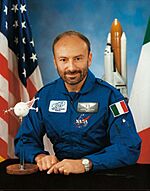
Genoa is the birthplace of famous scientists like Giovanni Battista Baliani and Vincentio Reinieri, the geneticist Luigi Luca Cavalli-Sforza, Nobel Prize winner Riccardo Giacconi (astrophysicist), and astronaut Franco Malerba. The city hosts the Erzelli Hi-Tech Park and the annual Festival della Scienza (Science Festival).
Erzelli Science Technology Park
The western part of Genoa is home to the Erzelli GREAT Campus, a growing science park. It houses high-tech companies like Siemens and Ericsson, and robotics laboratories of the Italian Institute of Technology (IIT). The plan is for the new Faculty of Engineering of the University of Genoa to also be located here.
Getting Around Genoa
Ports and Cruises
Genoa's port has several terminals for cruise ships and ferries. In 2007, over 3.2 million passengers passed through. MSC Cruises uses Genoa as one of its main home ports, competing with the Genoese company Costa Cruises. The passenger terminals have 5 berths for cruise ships and 13 for ferries, handling millions of passengers and cars each year.
The historic maritime station of Ponte dei Mille is now a modern cruise terminal. A third cruise terminal is being built in the Ponte Parodi area.
Air Travel
The Genoa Airport is built on an artificial peninsula, about 4 nautical miles west of the city. It connects Genoa with daily flights to major cities like Rome, Naples, Paris, London, Madrid, and Munich. In 2008, over 1.2 million passengers used the airport.
Public Transportation
The main train stations are Genoa Brignole in the east and Genoa Principe in the west. These stations connect Genoa to France, Turin, Milan, and Rome.
Genoa's hilly landscape means it has unique public transport. The city has two funicular railways (like cable cars on tracks), an inclined elevator, a rack railway, and ten public lifts.
The city's metro, bus, and trolleybus network is run by AMT. The Genoa Metro is a light metro line connecting Brin to the city center. It was extended to Brignole Station in December 2012.
Genoa's Culture
Visual Arts
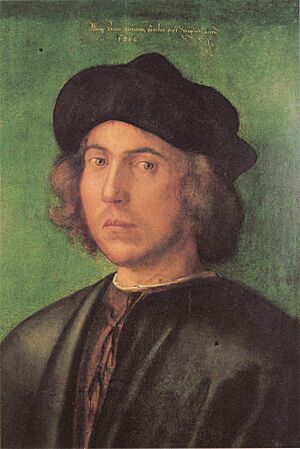
Genoa has a rich history in art. In the 16th century, famous Flemish painters like Rubens and Van Dyck lived and worked in Genoa, creating a special "Genoese Painting School."
Many of the city's artworks are found in its churches and palaces, with beautiful Renaissance, Baroque, and Rococo frescos. The Cathedral and the Chiesa del Gesù e dei Santi Ambrogio e Andrea have works by Rubens. The Palazzo Bianco holds "Ecce Homo" by Caravaggio, and the Palazzo Rosso has works by van Dyck and Dürer.
Famous Genoese painters include Luca Cambiaso and Bernardo Strozzi. Sculptors include Filippo Parodi.
The famous writer and architect Leon Battista Alberti was born in Genoa in 1404. Simonetta Vespucci, considered one of the most beautiful women of her time, was also born here. She was painted by Sandro Botticelli in The Birth of Venus.
Genoa is also known for its beautiful tapestries and its unique cobblestone streets called Risseu. The city has been compared to a "Mediterranean New York" because of its tall buildings and its strong connection to the sea.
Literature
"Anonymous of Genoa" was one of the first authors in Italy to write in the local language. It's said that Marco Polo and Rustichello da Pisa wrote The Travels of Marco Polo while in prison in Genoa's Palazzo San Giorgio. The Golden Legend, a collection of stories about saints, was written by Archbishop Jacobus de Voragine of Genoa.
Genoa is the birthplace of famous writers and poets like Giuseppe Mazzini and Nobel Prize winner Eugenio Montale. Many writers have been inspired by Genoa, including Charles Dickens and Mark Twain.
Since 1995, Genoa has hosted the Genoa International Poetry Festival every June.
Music
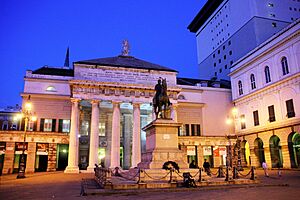
Genoa was an important center for Occitan culture and had a strong school of troubadours (poet-musicians).
Genoa is the birthplace of the famous violinist and composer Niccolò Paganini. His violin, Il Cannone Guarnerius, is kept in Palazzo Tursi. The city also has the Niccolò Paganini Music Conservatory.
In 1847, Goffredo Mameli and Michele Novaro composed "Il Canto degli Italiani" (The Song of the Italians), which became Italy's national anthem.
The Teatro Carlo Felice is the main opera house in Genoa. It was built in 1828 and has hosted famous conductors like Mascagni and Stravinsky.
Genoa is also known for its traditional polyphonic (many voices) vocal music called trallalero, sung by dock workers. Another traditional style is the "Nostalgic Song," which often tells stories of Genoese emigrants.
In the second half of the 1900s, Genoa became famous for its "Genoese School" of singer-songwriters. This group included popular artists like Umberto Bindi, Luigi Tenco, Gino Paoli, Bruno Lauzi, and Fabrizio de André.
Cinema
Genoa has been the setting for many films. Famous directors born in Genoa include Pietro Germi and Giuliano Montaldo. Actors from Genoa include Vittorio Gassman and Paolo Villaggio.
In 1985, some scenes for the movie Pirates by Roman Polanski were filmed in Genoa. The galleon Neptune from the movie was left in the Old Harbour.
Language
The Genoese dialect (Zeneize) is the most important dialect of the Ligurian language. It's spoken in Genoa alongside Italian. Ligurian is considered its own language, part of the Romance family.
Sports
Genoa has two main football (soccer) teams: Genoa C.F.C. and U.C. Sampdoria. Genoa C.F.C. is the oldest football club in Italy, founded in 1893. They have won 9 championships. U.C. Sampdoria was founded in 1946 and has won one Italian championship. Both teams play their home games at the Luigi Ferraris Stadium. The local football rivalry is called the Derby della Lanterna.
Genoa also hosts the AON Open Challenger international tennis tournament. The city has rugby and basketball teams as well. Genoa hosted games for the FIFA World Cup in 1934 and 1990.
Cuisine
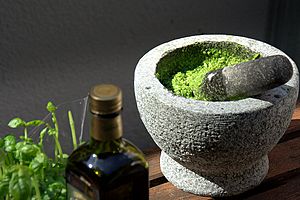
Genoese food is famous for its sauces, especially Pesto sauce, made with fresh basil, pine nuts, cheese, garlic, and olive oil. Other popular sauces include garlic sauce (Agliata) and "Walnut Sauce."
Genoese cuisine also features many types of pasta like Trenette, Corzetti, and Trofie. You'll find dishes like Farinata (a chickpea pancake) and various types of focaccia, including "Focaccia with cheese."
Fish is a key ingredient, with many varieties like Sardines, Anchovies, and Swordfish. Cheeses like Brös and sausages like Genoa salami are also popular.
Two special Genoese dishes are Cappon magro (a rich seafood salad) and Cima alla genovese (stuffed meat). The sweet bread Pandolce also comes from Genoa. The city gives its name to a special cake batter called Genoise and to the Pain de Gênes (a type of almond cake).
Genoa has many food markets, often in old 19th-century iron buildings, where you can find fresh local products.
Famous People from Genoa
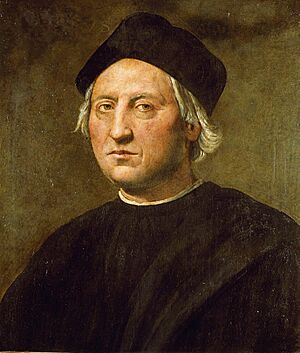
Many famous people have come from Genoa or been inspired by it. The philosopher Friedrich Nietzsche loved Genoa, and writers like Charles Dickens and Mark Twain wrote about the city.
Notable Genoese people include:
- Popes: Innocent IV, Adrian V, Innocent VIII, and Benedict XV.
- Explorers: Christopher Columbus, Antonio de Noli, and Andrea Doria.
- Composers: Niccolò Paganini and Michele Novaro.
- Italian patriots: Giuseppe Mazzini and Goffredo Mameli.
- Architect: Renzo Piano.
- Nobel Prize winners: Riccardo Giacconi (Physics) and Eugenio Montale (Literature).
- Comedians: Gilberto Govi, Paolo Villaggio, and Beppe Grillo.
- Singer-songwriters: Fabrizio de André, Ivano Fossati, Umberto Bindi, and Bruno Lauzi.
- Actor: Vittorio Gassman.
- Saints: Romulus, Syrus, and Catherine of Genoa.
Museums to Visit
- Accademia Ligustica di Belle Arti
- Albertis Castle
- Doge's Palace, Genoa
- Edoardo Chiossone Museum of Oriental Art
- Galata - Museo del mare (Museum of the Sea)
- Galleria d'arte moderna (GAM) (Modern Art Gallery)
- Lighthouse of Genoa
- Mackenzie Castle
- Museo Civico di Storia Naturale di Genova (Natural History Museum)
- Museo diocesano
- Museo di Santa Maria di Castello
- Museo Giannettino Luxoro
- Museum of Contemporary Art Villa Croce
- Museo del Risorgimento e istituto mazziniano
- Museum of Sant'Agostino
- Museo navale di Pegli (Naval Museum)
- Palazzo Bianco
- Palazzo Reale
- Palazzo Rosso
- Palazzi dei Rolli
- Palazzo Spinola di Pellicceria
- Via del Campo 29 rosso
- Villa Grimaldi Fassio - Raccolte Frugone
- Villa Durazzo-Pallavicini
- Wolfsoniana
Beautiful Promenades
Corso Italia is a 2.5-kilometer promenade in the Albaro district. It runs along the sea, offering views towards Portofino. Key sights include the Punta Vagno lighthouse and the San Giuliano Abbey.
The Passeggiata Anita Garibaldi is another beautiful 2-kilometer seaside promenade in Nervi.
You can also take walks from the city center along ancient paths and "Creuze" to reach higher areas. These spots offer magnificent views, like Belvedere Castelletto.
Monte Fasce provides a complete view of the city. You can also take the Genoa – Casella Old Railway, a 25-kilometer train ride through the Genoese mountains.
International Connections
Sister Cities
Genoa is connected with several cities around the world:
Cooperation Agreements
Genoa also has special agreements with many other cities, including:
- Athens, Greece
- Barcelona, Spain
- Buenos Aires, Argentina
- Havana, Cuba
- Lille, France
- Lyon, France
- Moscow, Russia
- Nice, France
- Saint Petersburg, Russia
- Turin, Italy
- Valparaíso, Chile
Consulates in Genoa
Many countries have consulates in Genoa to help their citizens and promote relations:
- Albania
- Austria
- Belgium
- Brazil
- Chile
- Colombia
- Denmark
- Ecuador
- Finland
- France
- Germany
- Greece
- Hungary
- Japan
- Malta
- Monaco
- Netherlands
- Norway
- Panama
- Peru
- Poland
- Portugal
- Romania
- Russia
- San Marino
- South Africa
- South Korea
- Spain
- Sweden
- Switzerland
- Thailand
- Tunisia
- Turkey
- United Kingdom
- United States
- Uruguay
Images for kids
-
Territories of the Republic of Genoa, around the Mediterranean & Black Sea coasts
-
Christopher Columbus, posthumous portrait by Ridolfo Ghirlandaio, c. 1520
-
Giuseppe Mazzini. His thoughts influenced many politicians of a later period, among them Woodrow Wilson, David Lloyd George, Mahatma Gandhi, Golda Meir and Jawaharlal Nehru.
-
The neoclassical Teatro Carlo Felice
-
Portrait of a Young Man, by Albrecht Dürer. Gallery of Palazzo Rosso.
-
The Italian astronaut Franco Malerba
-
Pesto, a popular Genoese sauce
See also
 In Spanish: Génova para niños
In Spanish: Génova para niños



